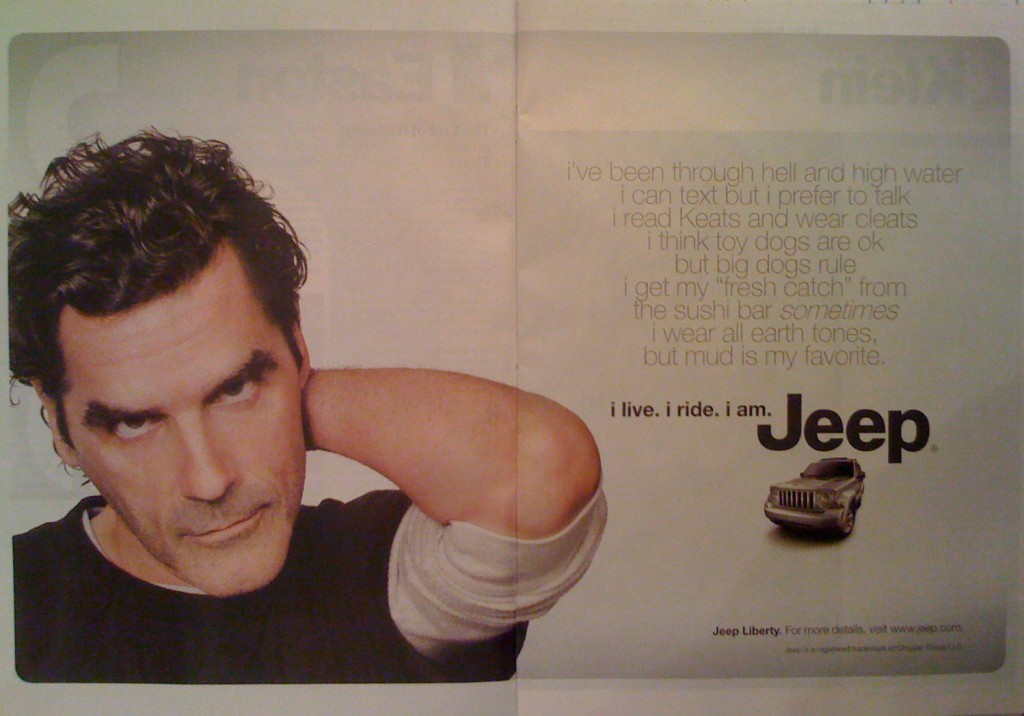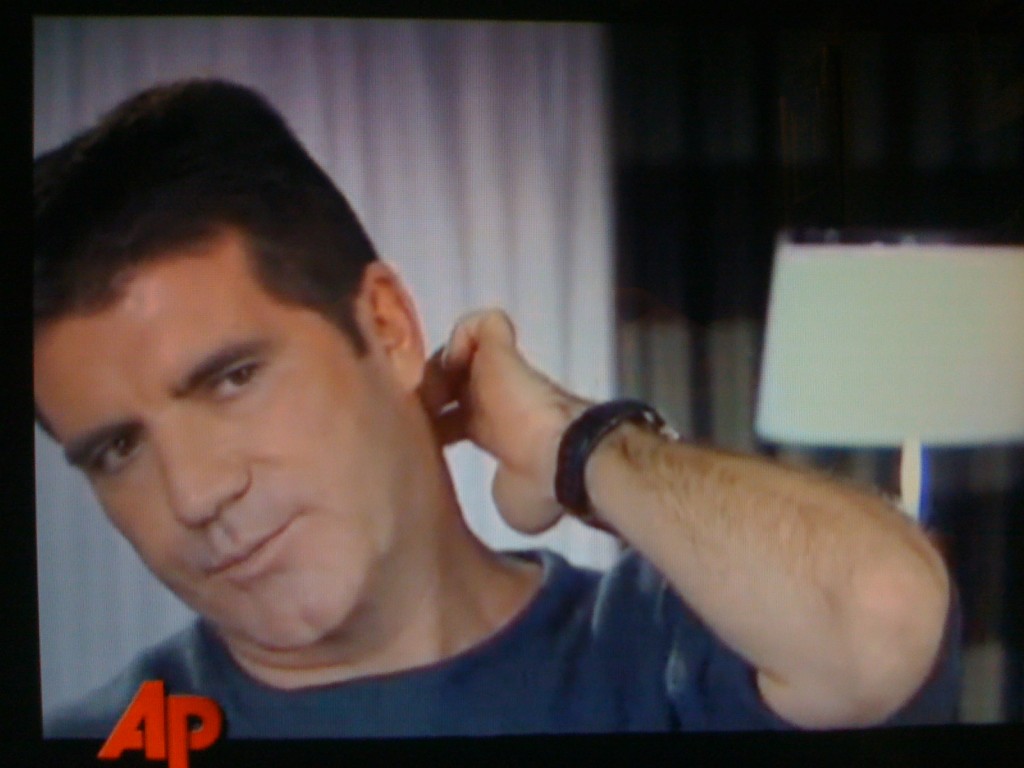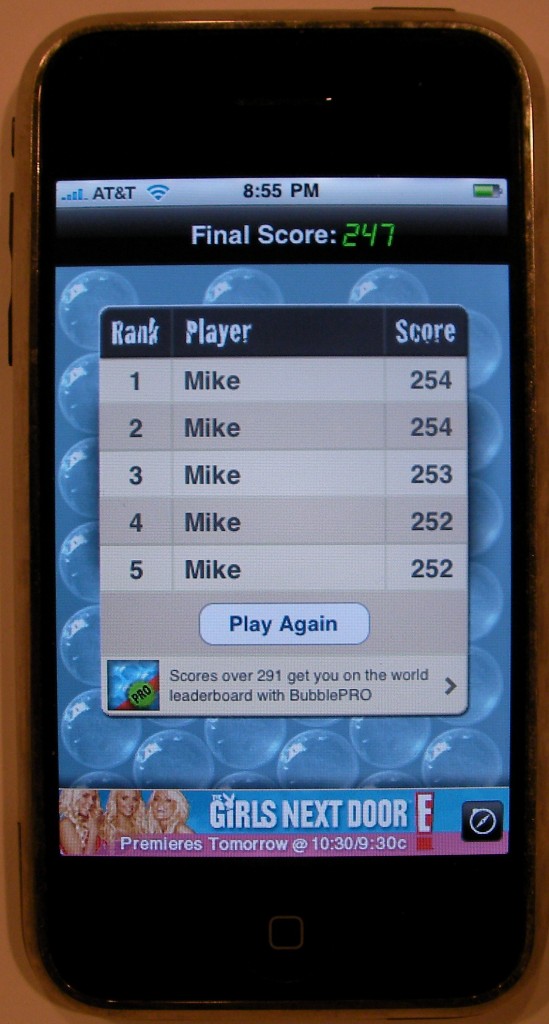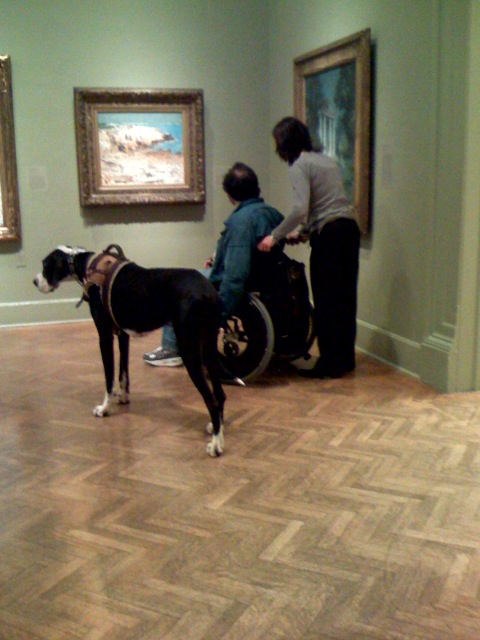Just found in my iPhone “Camera Roll” photo album an example of “accidental photography.” It’s dated March 5, 2014, at 10:10:19 PM. How this image came about is a mystery.
.
.
Just found in my iPhone “Camera Roll” photo album an example of “accidental photography.” It’s dated March 5, 2014, at 10:10:19 PM. How this image came about is a mystery.
.
.
The first six words in the title of this post — if you count each un-capitalized “i” as a word — is the tagline of a new advertising campaign for Jeep vehicles. The campaign’s 30-second TV commercials have not been well received by media observers. See, for example, comments here, here, and here. Jeep is also placing “i live, i ride, i am” advertisements in magazines, and in my opinion these are truly, madly, deeply, bad. I’m talking about text so awful it defies parody. Here is a two-page spread in the December 14, 2009 edition of TIME magazine (pages 34-35):
.

.
The words that appear in faint gray type in the upper right quadrant — the text providing the premise for the punchy tagline — reads as follows:
i’ve been through hell and high water
i can text but prefer to talk
i read Keats and wear cleats
i think toy dogs are ok
but big dogs rule
i get my “fresh catch” from
the sushi bar sometimes
i wear all earth tones,
but mud is my favorite.
Yes, those lower-case “i”s are indigenous to the copy. It wouldn’t surprise me if a phalanx of Apple attorneys were suspiciously eyeing those “i”s. It also wouldn’t surprise me if those same lawyers offer Chrysler, in lieu of crippling litigation, a friendly settlement proposal calling for minor changes in the tag line:
i live. i ride. i phone. i pod. i mac. i am.
But for now let’s give credit where credit is due. It was the Mad Men at Jeep’s advertising firm who came up with the idea of eschewing margins in favor of pseudo-poetically centering each of the nine descriptive lines. And it was their idea to italicize the word sometimes — a nuance sure to render many a reader weak-kneed.
I confess I was puzzled, however, to find the bold lack of punctuation surrendering to convention just when the statement reaches its final two lines. It’s as if the copywriter, almost done with the task, was suddenly touched by the ghost of her tenth grade English teacher, who whispered a plea: A comma and a period, please!
On the other hand, who among us can resist forming a wry smile at the rhyming of Keats with cleats? Clever.
As for the trendy sentiments expressed in the ad, yes, they’re sophomoric. But so what? (The visiting ghost came from the tenth grade, remember?) Maybe the whole thing is an homage to the malarkey found in the Manifesto of Thompson Hotels?
But enough about words. The bigger oddity is the photo in the left panel of the ad. This, presumably, is the Keatsian survivor of the fabled watery hell (or was it hellish waters?). This is a man who does not know for sure whether tonight’s dinner will include sushi. Can you blame him for scowling at us? Of course not.
But I wonder: Why was he asked to take a pose that is in-your-face and awkward, macho and goofy? Hey, I know the arm swing’s a guy thing; I do it too. But here’s the risk: Someone will be tempted to suggest this guy’s next gig ought to be on stage playing opposite Katisha (She: “My right elbow has a fascination that few can resist.” He: “Ditto my left, baby.”)
Is it just me, or do you also find the more you stare at the picture the more his bare forearm looks like a raw turkey drumstick attached to his left ear? (OK, maybe it’s just too close to Thanksgiving for me.) Whether it be a drumstick or an arm, the fact is the thing’s projecting forward from pictorial space, and none too elegantly. As artists will testify, foreshortening can be a bitch. See, for example, Durer’s posthumously published treatise, De Symmetria. So why did the creator of the ad go there, and why compound the problem by featuring a limb that’s freakishly fingerless?
At least when we watch Simon Cowell’s bad habit of scratching the back of his neck, we see him in motion (as in this video at 1:41 – 1:43) and we get to see his hand, as shown in this screen shot:
.

.
[As for the title of this post, if you want to read more about “i yi yi” (aka, “Aye Yi Yi”), an expression used to show frustration, hopelessness, sadness, annoyance, click here and here.]
From an article in The Wilson Quarterly, online here, comes this observation by Tyler Cowen:
“The measure of cultural literacy today is not whether you can ‘read’ all the symbols in a Rubens painting but whether you can operate an iPhone or other web-related technologies.”
. . .
In recent days this blog has received a spate of comments from spammers fronting for online “pharmacies” (if you know what I mean). Each message begins by recounting a joke (to lower your defenses?). I thought one of the jokes was good enough to repeat here. It’s in the child-pleasing Q&A format and goes like this:
“What happens to illegally parked frogs?”
“They get toad away.”
.
.

.
“Bubblewrap” is the name of an addictive game available as a free app down-loadable to the Apple iPhone. Video of how the 45-second game is played is available here.
I’m a fan.
During each game session a variety of sounds are heard. There’s a “pop” as each bubble is tapped; a sucking sound when a deflated bubble decides to pump itself back up with air; a “crash” sound when you pop a rare bubble whose destruction is worth two points (“2X”) (there are no labels so you never know when this will happen); a bigger explosion when an even rarer “5X” bubble meets its demise; a “ticking” reminiscent of the theme of the “60 Minutes” TV program that starts when five seconds of play are left in the game; and a raucous clown-horn blurt that signals the game is ended. All in all a cool sonic landscape. It keeps you coming back for more.
Also satisfying are the inadvertent rhythms that sometimes arise, especially when 2X and 5X bubbles explode in quick succession. Hearing a dah-dah-dah-DUH sequence toward the end of play is always welcome — it means your score just grew by 11 points and you may be fated to achieve a new high. The goal, of course, is to get an ever-higher score. (Isn’t that life-like?)
Speaking of life-like, playing Bubblewrap, like playing at a casino craps table or pulling a one-armed bandit, provides an opportunity to reflect on the fact that human psychology wants very much for non-living objects to be more like us. Especially is this so if we’re spending time interacting with a device in the hope of receiving something positive in return. (Are you listening, direction-giving lady navigator in my Prius?) If man is the measure of all things, wouldn’t it be nice if things really were more like us? I suspect this desire is innate, part of our DNA. If so, it suggests all human societies, however primitive, however temporarily misguided, will strive toward a Renaissance. And that’s a good thing, no?
[Aside: Waxing philosophical made me think of wax paper. Wax paper used to be a staple item in every home kitchen but now has disappeared. What happened? Is the answer as simple as two words, Saran Wrap? A name whose final word leads me back to the subject at hand . . . .]
A useful technique when playing Bubblewrap is to use a three-finger (index, middle, ring) approach, dancing the finger pads across the field of bubbles. After an initial sweep across the screen to pop all standing bubbles (which takes just a few seconds) you enter the re-inflation period when, one-by-one, each crumpled bubble does its Lazarus act. During this major phase of play I find it best to enter into an intuitive mode, a Zen-like state, floating over the bubble field, in tune with Wayne Gretzky’s advice to skate to where the puck (or the refurbished bubbles) will be.
Though not of “world leadership” rank, I’ve done pretty well so far, if I do say so myself. But have I hit a wall? —
.
.
My prior cell phone, an LG, could store 20 photos. My iPhone can store, what, tens of thousands? Here are four from 2008.
1. First up, a photo that could be titled “Museum Dog.” A couple of years ago, while visiting the Getty Museum in LA, I saw a woman on a Segway roaming through the galleries. From time to time she would pivot and halt in front of a painting that caught her eye. I said to myself, “Now this is a museum with an enlightened admission policy; they’d never allow that back East.” Well, here’s evidence that when it comes to disabled visitors, the Corcoran Gallery of Art in DC does “enlightened admissions policies” just as well.

2. Although probably not as museum-worthy as a Klee or Miro, the bold, primitive rendering below has, I believe, an equal claim to be trimmed with an explanatory label, like this:
“Figure with Small Companion, created 2008, anonymous child artist, colored chalks on concrete, approx. 36 by 36 in. (destroyed 2008, by rain).”

3. Moving on to sculpture, in October I myself took a stab at carving Dick Cheney as a Halloween pumpkin.

The day after his first night on the porch, Cheney suffered a cruel fate: extraordinary rendition into the paws of ravenous squirrels. Nibbled beyond repair, he had to be put down.
4. Lastly, a photo of a parking garage at night. In the corner rests a seductive red sports car, as if awaiting the start of her starring role in a film noir.
